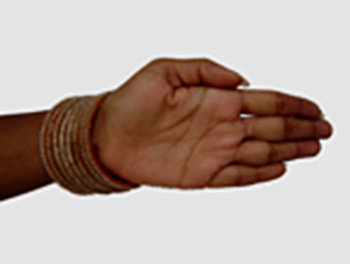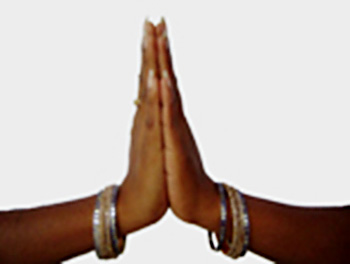 Hastabhinaya or gestures of the hands is an imperative part of the Natyashastra. The activity of the hands helps to enhance the performance of a play. Hastabhinaya can be categorised into two parts, Asarhyuta (non combined) and Samyuta {combined). Gestures of the Asarhyuta hands are twenty four in number and those of Samyuta hands are thirteen. The Asarhyuta hands are namely, Pataka, Tripataka, Kartarimukha, Ardhacandra, Arala, Sukatunda, Musti, Sikhara, Kapittha, Katakamukha, Suchimukha, Padmakosa, Sarpasirsa, Mrigasirsa, Kangula, Alapadma, Catura, Bhramara, Hamsasya, Hansapaksa, Sandamsa, Mukula, Urnanabha and Tamracuda. In Samyuta hands there are thirteen types of gestures namely, Anjali, Kapota, Karkata, Svastika, Khataka, Utsanga, Nisadha, Dola, Puspaputa, Makara, Gajadanta, Avahittha and Vardhamana.
Hastabhinaya or gestures of the hands is an imperative part of the Natyashastra. The activity of the hands helps to enhance the performance of a play. Hastabhinaya can be categorised into two parts, Asarhyuta (non combined) and Samyuta {combined). Gestures of the Asarhyuta hands are twenty four in number and those of Samyuta hands are thirteen. The Asarhyuta hands are namely, Pataka, Tripataka, Kartarimukha, Ardhacandra, Arala, Sukatunda, Musti, Sikhara, Kapittha, Katakamukha, Suchimukha, Padmakosa, Sarpasirsa, Mrigasirsa, Kangula, Alapadma, Catura, Bhramara, Hamsasya, Hansapaksa, Sandamsa, Mukula, Urnanabha and Tamracuda. In Samyuta hands there are thirteen types of gestures namely, Anjali, Kapota, Karkata, Svastika, Khataka, Utsanga, Nisadha, Dola, Puspaputa, Makara, Gajadanta, Avahittha and Vardhamana.
Asarhyuta Hands
Where all the fingers are extended keeping them close to one another with the thumb bent, the gesture is called Pataka. This gesture is applied when it is required to represent continuous shower of blows, warming near the fire, nudging others, excessive delight and proud indication of oneself. Those conversant with the use of this gesture should place the hand with the gesture on a level with the forehead. The Tripataka gesture is used in invocation, stepping down, dismissal, obstruction, gaining access, lifting up, bowing down, observing similarity, putting out alternatives and suggestions, touching holy and auspicious objects or placing them on the head, wearing the turban or any head gear or putting on the crown, covering the nostril, mouth or ear etc are represented. In the Tripataka hand if the index finger faces the back of the middle finger it is the Kartarimukha gesture.
 The hand wherein the fingers along with the thumb are kept bent depicting a bow is well known as Ardhacandra. The pot, bracelet, forward thrust, excessive exertion, slenderness of the waist, the girth etc. should be represented by means of this hand. In the Arala hand the index finger is bent like a bow; the thumb is kept curved and the remaining ones separate and turned upwards. With this gesture inherent strength, pride, exploit, beauty, divine objects, majesty, blessings and similar pleasing Bhavas are to be represented. When ring finger in the Arala hand becomes bent it is called Sukatunda. If the ends of the fingers are kept close to the palm and the thumb is placed above them it is termed Musti. This hand is applicable in regard to the representation of striking, exercising, massaging, grasping of swords, lances and clubs etc. If the thumb of the Musti gesture is lifted up it should be known as Sikhara hand by those who employ the gesture. In the gesture named Shikhara, if the forefinger is kept curved and pressed down by two thumbs, it is then remembered as Kapittha.
The hand wherein the fingers along with the thumb are kept bent depicting a bow is well known as Ardhacandra. The pot, bracelet, forward thrust, excessive exertion, slenderness of the waist, the girth etc. should be represented by means of this hand. In the Arala hand the index finger is bent like a bow; the thumb is kept curved and the remaining ones separate and turned upwards. With this gesture inherent strength, pride, exploit, beauty, divine objects, majesty, blessings and similar pleasing Bhavas are to be represented. When ring finger in the Arala hand becomes bent it is called Sukatunda. If the ends of the fingers are kept close to the palm and the thumb is placed above them it is termed Musti. This hand is applicable in regard to the representation of striking, exercising, massaging, grasping of swords, lances and clubs etc. If the thumb of the Musti gesture is lifted up it should be known as Sikhara hand by those who employ the gesture. In the gesture named Shikhara, if the forefinger is kept curved and pressed down by two thumbs, it is then remembered as Kapittha.
When the ring finger along with the little finger of the Kapittha gesture is raised and bent it is called Katakamukha. In the index finger in the Hasta named Kafaka is stretched that Hasta should be known as Suchimukha. The Padmakosa hand represents offering of Puja to a deity, carrying tribute casket, offering of the Agrapinda and a number of flowers gathered together. In Sarpasirsa all the fingers not excluding the thumb are kept close to one another and the palm of the hand is hollow. When all the fingers are kept downwards except the thumb and the little finger which are to be kept raised up is called Mrigasirsa. In Kangula the little finger is raised, the ring finger is kept bent and the three other fingers viz. the middle the forefinger and the thumb are kept separated, like the holy fires. When the fingers are separated from one another and are kept turned towards the palm in a circular way it is called Alapadma.
 Catura gesture is when three fingers are spread. The little finger is lifted up and the thumb is kept within them. Two Catura hands combined together are employed to indicate comparison between the eyes and petals of lotus and also the ears of deer. In the Bhramara, the middle finger and the thumb cross each other, the index finger is bent and the other two fingers are separated and raised. When the forefinger, middle finger and the thumb are kept without any intervening space and the remaining fingers are kept stretched, it is Hamsasya. In Hansapaksa three fingers are kept stretched resembling the wings of a swan; the small finger is kept raised and the thumb is kept bent. When the thumb and the forefinger in the position of Arala hand are kept crossed like pincers and the palms is slightly hollowed it is Sandamsa hand. In Mukula, the fingers, are bent and kept close to one another in the form of a bud as it were when their tips meet together in the Harhsasya hand. The Urnanabha hand is usually employed to represent the combing of the tresses, receiving stolen property, scratching the head, lions, tigers and holding a stone. In Tamracuda, the middle finger crosses with the thumb, the index finger is kept bent, the remaining two fingers resting on the palm.
Catura gesture is when three fingers are spread. The little finger is lifted up and the thumb is kept within them. Two Catura hands combined together are employed to indicate comparison between the eyes and petals of lotus and also the ears of deer. In the Bhramara, the middle finger and the thumb cross each other, the index finger is bent and the other two fingers are separated and raised. When the forefinger, middle finger and the thumb are kept without any intervening space and the remaining fingers are kept stretched, it is Hamsasya. In Hansapaksa three fingers are kept stretched resembling the wings of a swan; the small finger is kept raised and the thumb is kept bent. When the thumb and the forefinger in the position of Arala hand are kept crossed like pincers and the palms is slightly hollowed it is Sandamsa hand. In Mukula, the fingers, are bent and kept close to one another in the form of a bud as it were when their tips meet together in the Harhsasya hand. The Urnanabha hand is usually employed to represent the combing of the tresses, receiving stolen property, scratching the head, lions, tigers and holding a stone. In Tamracuda, the middle finger crosses with the thumb, the index finger is kept bent, the remaining two fingers resting on the palm.
Samyuta Hands
When two Pataka hands are put together it is called Anjali. It is employed to great friends; receive venerable persons and making obeisance to deities. A ferocious approach with inimical intention is indicated by the Kapota hand. The Karkata hand is resembled by interlocked fingers. Two Arala hands kept upturned and held together at the wrists constitutes of the Svastika hand. Khataka is the combination of two Kataka mukha hands i.e. one is placed on another at the wrist. In Utsanga the Arala hands are placed in a contrary manner. Its main use is to represent the feeling of touch. If the Mukula hand is unturned with Kapittha hand it is Nisadha hand. Patience, intoxication, arrogance, magnanimity, eagerness, valour, conceit, haughtiness, absence of motion, steadiness etc. are indicated by this hand. When both the shoulders are at ease in a Karana and two Pataka hands long down, it constitutes the Dola hand. In Puspaputa hand, two Sarpasirsa hands with the fingers close to one another meet on one side intimately.
When two Pataka hands are turned down and placed on each other with the thumbs kept raised, it is the Makara hand. Its employment is for the representation of lion, tiger, elephant, crocodile, shark, fish and flesh eating animals. The Gajadanta hand is the combination of two Sarpasirsa hands mutually touching the opposite arms between the elbow and the shoulder. The carrying of the bride and the groom, excessive weight, clasping a pillar and the extermination of a hill or a boulder are indicated by the Gajadanta hand. In the Avahittha hand, there is a combination of two hands meeting each other on the breast. They are bent and slowly lowered. This hand is to be employed to represent weakness, sigh, revelation of one`s own body and the yearning for a beloved. In the Vardhamana hand, there is the combination of the Mukula hand and Kapittha in close clasp.




















